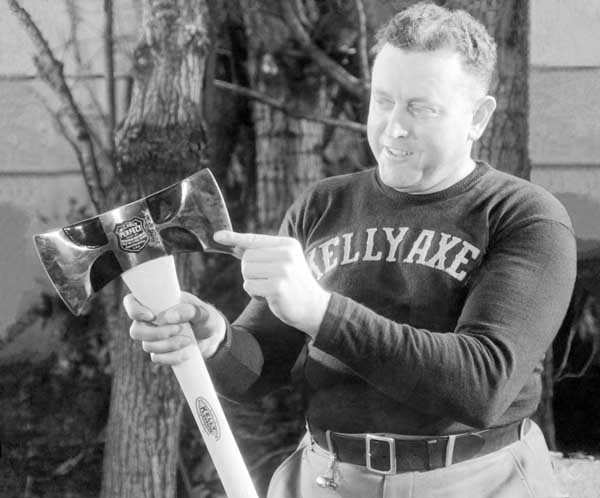"Kelly Perfect"
Annabelle Rhodes Recalls Kelly Axe
By Amy M. Harper

Kelly woodsman Paul Criss with a W.C. Kelly Perfect Axe, circa 1942. Photograph courtesy of West Virginia State Archives, Irene W. Mann Collection.
Any collector of American hand tools wants a W.C. Kelly Perfect Axe. Today's buyers know that prices can range from a mere $10 to well over $100, when manufacturing date and condition are taken into consideration. The Kelly Perfect Axe was made by the Kelly Axe Manufacturing Company, which operated in the Charleston area from 1904 until 1982. At one point it was the world's largest in axe manufacturing — one reason collectors look for the Kelly Perfect.
For decades, the factory supplied countless West Virginia families a means of employment. Even today it is difficult to find a longtime Charleston resident who does not have a connection to the once-prominent riverfront factory.
Such was the case for Annabelle Doughty Rhodes of Sissonville, Kanawha County. More than half of her 97 years were somehow connected to “Kelly's" — the shortened name employees dubbed the factory despite its ownership changes over the years.
Annabelle’s grandfather, Civil War veteran Isaac Wesley Doughty, settled in Fletcher near Kentuck, Jackson County, in the late 1800's. His property gave Annabelle's parents, John and Mary Doughty, a place to build their own cabin in 1894. Mary bore 11 children. Annabelle, the 10th child, arrived on Christmas Day 1913. She lived until December 6, 2011.
Like others in Fletcher, John Doughty provided for his family by living off of the land. Annabelle explained, “Back in those days, people farmed and they raised their own stuff. Then they'd go to Ripley and buy the things that they would have to have, like flour, and coffee, and the stuff they didn't raise.”
Annabelle's mother and father would take the trip to Ripley by wagon twice a year, in the spring and fall. They would camp overnight along the Mill Creek. Material for making clothes, brown sugar, and spices were among the things Mary and John usually purchased before traveling the 25 miles back to Fletcher.
“My parents raised their own corn and took it someplace to have it ground, you know, and that way they didn't have to buy meal,” Annabelle recalled. Her mother would then sift the meal to make cornbread. “I remember that cornbread. It was awful good.”
In 1919, Mary and John separated. Though an uncommon incident during the time period, the circumstances were understandable. Mary was only 13 years old when she married, under the arrangements of her parents. John, a widower and father of four, was already 35. For about 27 years, Mary played the role of wife, stepmother, and mother, but the year 1917 devastated the family. Annabelle remembered that the entire family suffered through the flu epidemic. Mary and John lost two of their 11 children just seven days apart. Austin was 16, and Aubrey only 11. Mary was never the same after their deaths.
In time Mary packed her belongings, taking with her the younger children — Henry, Melford, Virginia, Opal, and Annabelle. They moved by riverboat on the Ohio River to Lesage, Cabell County. The older children — Netra, Myrtle, Stella, and Enos — were grown and married. They remained in Jackson County.
The family traveled from Lesage to Gallipolis, Ohio, where they stayed for a short time. Then in 1919, Mary moved some of the children with her to Charleston. Annabelle returned to Jackson County and stayed for two years with her older sister Netra and attended Straight Run Grade School for second and third grade.
Eventually Annabelle joined her family in Charleston. It was this move that put her in close proximity to the Kelly factory. She attended Tiskelwah, Slip Hill, and Sugar Creek grade schools, completing through the eighth grade.
Like others in the 1920's, Annabelle had to leave school to help provide for her family. She remembered how she felt about leaving school: “I didn't want to really. I would have been going to high school then you see, and I didn't have the clothes that I thought I should have. That’s one of the reasons I think I quit more than anything else. My mother, Opal, and myself, and my brother lived together at that time. And she could use a little extra money I give her.”
Annabelle’s job for the next 12 years was in the hammer department of Kelly's axe factory. She began in 1927 at the age of 14.
In the early 1900's, the factory's owner, William C. Kelly, had purchased about 53 acres along the north side of the Kanawha River, where Patrick Street Plaza is today. West Virginia's natural gas supply and cooler nights, as well as the site's accessibility to transportation on the river, convinced Kelly to move his then Indiana-based factory to Charleston. The factory experienced continual growth in its early years. By this time, W.C. Kelly was in his 50’s and an experienced businessman who was reaching an international market. He stated in a March 1925 Charleston Gazette article that about 20% of the factory's output was sold outside of the United States.
Land deed records show that over the next several years Kelly's axe company continued purchasing lots in the Charleston area.
You can read the rest of this article in this issue of Goldenseal, available in bookstores, libraries or direct from Goldenseal.